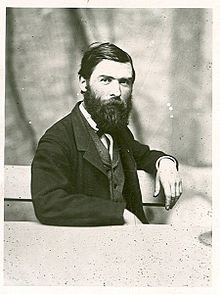Laurenz Heinrich Hetjens
Laurenz Heinrich Hetjens (born July 16, 1830 in Düsseldorf , † May 26, 1906 in Aachen ) was a German art collector . His private collection formed the basis for the German Ceramic Museum .
Life
Hetjens came from a humble background. He grew up with seven siblings on Citadellstrasse in Düsseldorf. At the age of 12, Hetjens was trained as a saddler in 1842 and, after completing his apprenticeship, he worked as a journeyman at the Royal Prussian Post Car Company in Düsseldorf from 1845 to 1851 . In addition to his employment, he took drawing lessons as a guest student at the Düsseldorf Art Academy . Here he was taught by his cousin and engraver Heinrich Kipp (* 1826) and the painter Carl Emanuel Conrad . As a journeyman craftsman, Hetjens went on a journey and came to Aachen in 1851, where he settled and on August 12 of that year found a job in the court carriage factory and body shop Joseph Mengelbier . Here he benefited from his talent for drawing. Until 1854 he designed new models of carriages for Mengelbier. In Aachen he met the English industrialist RW Grice, the director of the first Aachen gas works , who appointed him technical director of the gas works in 1860.
On November 21, 1866, he married Maria Catharina, 14 years his senior, the wealthy widow of the Belgian machine manufacturer Johann Noël Regnier.
Hetjens collection
Main article Hetjens Museum
The wealth of his wife made it possible for Hetjens to retire from his professional life and to devote himself to his passion for collecting art objects. Hetjens placed the focus of his collection on Rhenish stoneware . As an autodidact, he acquired extensive specialist knowledge in this area. When purchasing the ceramic vessels, he was not only satisfied with the offer in the art trade, but also financed excavations in the Rhenish pottery districts of Raeren and Siegburg , in which he also participated personally between 1870 and 1882. Although Hetjens planned to publish his collection, he could not complete this work until his death.
Since Hetjens remained childless, he made his hometown Düsseldorf the sole heir in his will, but decreed that the city should build a museum for the Hetjens collection within a year (the will kept 150,000 gold marks ready for this), which would be named after the founder for ever had to become. In addition, he obliged the heirs to employ Heinz Ritzerfeld , who had been with him for several years as a restorer and private secretary, as director of his museum for life. Otherwise the city of Cologne will be used as a successor.
After Hetjens death, the city of Düsseldorf fulfilled the legacy of Hetjens and built the Hetjens Museum in 1907/1908 on Hofgartenufer 3, on the north wing of the then Kunstpalast . In 1969 the Hetjens Museum moved to the Palais Nesselrode in Düsseldorf's Citadellstrasse, the street where Hetjens was born.
literature
- Karl Koetschau : Rhenish stoneware. Munich 1924. pp. 3–5.
- Ralf Mennicken: My friend Hetjens. The collector Laurenz Heinrich Hetjens in the light of his time. Materials for Raeren Pottery Volume 3. Raeren 2006. Digital version (PDF; 2.7 MB)
- Joachim Naumann: Hetjens Museum Düsseldorf - German Ceramic Museum. Ceramic from 8000 years. Deutscher Kunstverlag Munich, Berlin 1994. pp. 2f.
- Sally Schön: Passion for ceramics. The Hetjens Museum in Düsseldorf and its collection history. Reimer Verlag, Berlin 2009.
Web links
- History of Hetjens , on the website of the city of Düsseldorf
- Article at rp-online on the 100th anniversary of Hetjens death
- Works by and about Laurenz Heinrich Hetjens in the German Digital Library
Individual evidence
| personal data | |
|---|---|
| SURNAME | Hetjens, Laurenz Heinrich |
| ALTERNATIVE NAMES | Hetjens, Heinrich |
| BRIEF DESCRIPTION | German art collector |
| DATE OF BIRTH | July 16, 1830 |
| PLACE OF BIRTH | Dusseldorf |
| DATE OF DEATH | May 26, 1906 |
| Place of death | Aachen |

